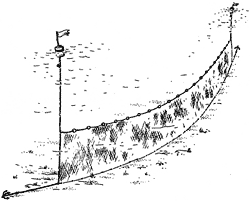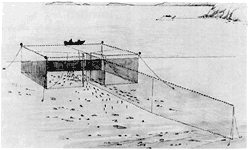Sentinel Fisheries - Fishing Gear
The use of these gears in the northern Gulf of St. Lawrence sentinel fisheries makes it possible to calculate abundance indices that are complementary in time, in space and in terms of the size of the cod sampled. The spatio-temporal overlapping of the fixed (longlines and gillnets) and mobile gear (trawls) in July and October provides a complete picture of the northern Gulf. Taken as a whole, the sampling makes it possible to monitor migration and other biological characteristics (diet, condition…) of cod of various sizes throughout the entire area.
Longline

Longlining, as the name implies, involves the use of a “long line” with a series of baited hooks spread along the ocean floor. Initially retrieved manually, this system has now become mechanized and uses automatic hauling, baiting and shooting machines. These improvements have made longline an increasingly popular form of fishing. Fishermen are able to fish more gear, and in many other ways can compete with other forms of fishing. They can be more selective, landing a higher quality of fish, and also require less fuel operation. Longlining is used primarily in the Atlantic provinces to catch groundfish such as cod, hake, haddock and halibut. (MPO. 1989. Atlantic Fishing Methods, Underwater world. 12 p.).
Gillnets


Gillnets are used on the Atlantic coast to catch many species of fish, especially groundfish and pelagics and such anadromous species as salmon, smelt and alewife. They are constructed principally of monofilament netting and may be either secured to the bottom of the sea with the use of weights or left to drift. Fish are caught as they attempt to swim through the webbing, entangling their gills.
Nets which are anchored to seabed to keep the gear stationary have buoys on each end which float on the surface. These buoys indicate the location and ownership of the gear and provide a line from which the gear can be raised to the surface to harvest the catch. The nets may be positioned in varying water depths, depending on the location of the species. It is common for fishermen to join a number of nets together to increase the efficiency of the operation.
The size of the mesh used in gillnets may differ, depending on the species and size of fish sought. (MPO. 1989. Atlantic Fishing Methods, Underwater world. 12 p.).
Cod Traps

Cod trap fishing is somewhat similar to weir fishing and is primarily used in Newfoundland. The traps resemble open-topped box nets, measuring 11 to 22 meters around the perimeter, with a vertical opening or ”door” on one side. The trap is set on the ocean bottom, usually close to the shore, with the door facing shallow water. It is buoyed on the top and anchored on each corner to maintain its position.
Along net fence or ”leader” extends from shallow water into the mouth of the trap. When the cod, feeding on fish such as capelin along the seashore, confront the leader, the instinctively shift direction, swimming through the open doors into the trap. Once inside, they tend to swim in circles, trying to avoid the leader and so fail to locate the doors. Fishermen then close the doors and bring the trap to the surface, hauling it across the boat. The fish are concentrated in one corner of the trap and collected with a dip net.
One cod trap vessel may tend up to four or five traps, although three or four are more common. (DFO. 1989. Atlantic Fishing Methods, Underwater world. 12 p.)
Otter Trawling

Otter trawls are cone-shaped nets which are towed along the ocean bottom to catch many species of groundfish. They take their name from the rectangular “doors” or “otterboards” that are attached to cables between the boat and the net. These doors serve to keep the mouth of the net horizontally open while the net is making its tow. A vertical opening is maintained by weights on the bottom and floats on the top and water pressure generated from towing. The net traps fish in the end of the bag-like section or ”cod-end”, which has a mesh size that permits only the smaller fish to escape. The net rolls along close to the bottom with the aid of bobbins, which are similar in appearance to wheels.
After a period of towing, the trawl is hauled up the ”stern ramp” and the cod-end is raised and suspended over the vessel. The cod-end is untied, and the released onto the vessel’s decks, where the fish are bled, gutted and stored in the hold. (DFO. 1989. Atlantic Fishing Methods, Underwater world. 12 p.)
Sentinel Fisheries Gears Specifications
Longlines are used in the northern Gulf of St. Lawrence sentinel fisheries to establish an annual abundance index of the adult segment of the cod stock. Because longlines are deployed in traditional fishing areas and seasons, the fishers involved know how to use this type of gear. Longlines are the only gear used in 3Pn. Their use gradually declines as one moves up the west coast of Newfoundland (4Rd, 4Rc, 4Rb, and 4Ra). They are seldom used on Quebec’s Lower North Shore (4Sw, 4Sv) and never used in 4Sy or 4Sz.
Gillnets are also used in the northern Gulf of St. Lawrence sentinel fisheries to establish an annual abundance index of the adult segment of the stock. Like longlines, gillnets are deployed in traditional fishing areas and seasons, the fishers involved already know how to use this type of gear. Their use in the sentinel fisheries program is the inverse of longlines, i.e., dominant in 4S, often used in 4R and not used at all in 3Pn. As a result, we get a complementary picture of the situation.
Cod traps have also been used in the northern Gulf of St. Lawrence sentinel fisheries as the gear of choice for tagging cod. This gear has the advantage of catching smaller cod. Tagging is currently done using handlines. Recaptures of tagged specimens makes it possible to evaluate growth, migration routes, and even potentially stock abundance. Cod caught using traps are vigorous and returned to the water under ideal environmental conditions in terms of their survival.
Trawls are also used in the northern Gulf sentinel fisheries. The advantage of this type of gear is that it can be used throughout the entire area, at depths from 20 fathoms (120 metres) to over 200 fathoms (366 metres). In contrast to fixed gears (traps, gillnets and longlines), trawls are deployed in accordance with a rigorous scientific protocol. The nine participating trawlers are equipped with a liner in the codend to capture cod as young as one year, making it possible to evaluate the importance of these new recruits. The nine trawlers were calibrated using a Scanmar system and the use of restrictor cable to reduce intervariability. The nine trawlers conduct two annual surveys, one in July and the other in October. The fishing positions are determined in advance by Fisheries and Oceans Canada staff and each fisher must trawl a specific number of stations. Trawls are therefore used to establish two annual cod abundance indices both for very young specimens and for the commercially available (fishable) segment of the stock.

